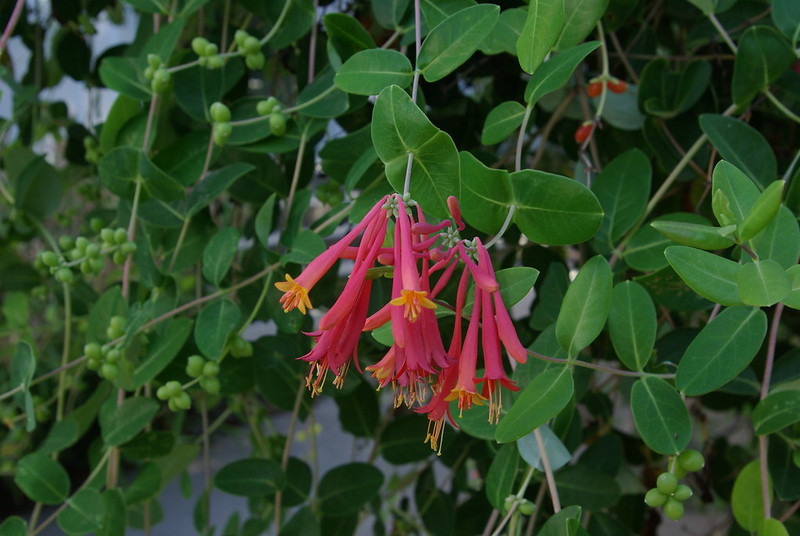Yesterday we found a coral honeysuckle vine (Lonicera sempervirens) growing up a tree on an abandoned property. It was covered in blooms, and looked beautiful amidst a backdrop of charred trash, broken glass, masonry and the obligatory rotten mattress.
I took a few cuttings that we’ll try to propagate after I finish writing this post. Back in my North Florida food forest, I had a coral honeysuckle growing up a tree to bring in pollinators and hummingbirds. I didn’t know much about the plant until I got one from my friend Connie Bonbrest, who used to run a little nursery booth called “The Potter’s Bench” which she set up near my Florida Food Forests booth at the now-defunct 326 Market north of Ocala.
My focus has mostly been on edible plants over the years, as I’ve always wanted to have plenty of food for our family that was A: in the backyard and B: not sprayed with poison, but once I had lots of food at our old North Florida property, I expanded into planting some plants for the wildlife as well.
Also called trumpet honeysuckle, this vine is best known for its bright red, tubular flowers. Clusters of blooms emerge on new growth in spring and summer. The flowers attract hummingbirds and butterflies for months before maturing into berries. These fruits draw songbirds in late summer and fall.
That sounds good. UF further relates:
Since it’s a vine, coral honeysuckle works well on trellises and fences. Individual stems can grow up to 15 feet in length. Training and pruning can help direct these and improve overall form. Honeysuckle can be planted as a ground cover, too. Vines like this one help control erosion on steep slopes.
Coral honeysuckle tolerates most soil types and conditions. It does best in slightly acidic soil but does not tolerate dry sands. It will grow in partial shade, but blooms best in full sun.
Coral honeysuckle is generally a low-maintenance plant once it’s established. It is drought tolerant and does not attract any particular pests.
Gardeners looking for this plant can find it at native plant nurseries. Some conventional nurseries have it in stock as well. You can also propagate new plants from cuttings.
Cuttings! Good. That’s what we’ll do.
Coral honeysuckle is a good plant to add to a food forest, even though it’s not known to be edible. The plant isn’t invasive and will fit somewhere in an open spot and attract beneficial wildlife.
It’s a beautiful plant. Though you don’t need a backdrop of charred trash to make it attractive, a mountain of ugly debris does give it that “please take cuttings and bring my children to a better place” look.
Image at top via Pam Morgan.


5 comments
One of my favorites.
You can also pick the blossoms off and suck the nectar out of the base, and they have a lovely scent in bloom.
We had a (standard yellow) honeysuckle in the yard when I was growing up, and it often was blooming on Independence day, when we had the family potluck in the back yard. When I lived overseas for a while, I remember going down a small side street and being struck with homesickness, and I realized that someone had planted honeysuckle in their yard and it was blooming. The scent is lovely and it meant “all the family at the potluck” to me.
We have some honeysuckle that is red and yellow. Maybe a hybrid?
The honeysuckle we have starts as a red bud that opens into pink flower that fades to white over a few days then turned yellow like the honeysuckle I grew up with in the mid west. Is this normal for Florida or is this unique to my property?
I am not at all familiar with the various types, so I don’t know.
Comments are closed.